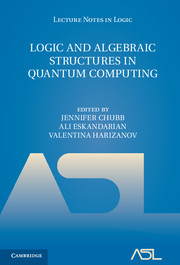Book contents
- Frontmatter
- Contents
- Preface
- Introduction
- 1 A (very) brief tour of quantum mechanics, computation, and category theory
- 2 Could logic be empirical? The Putnam-Kripke debate
- 3 The essence of quantum theory for computers
- 4 Fiber products of measures and quantum foundations
- 5 Operational theories and categorical quantum mechanics
- 6 Relating operator spaces via adjunctions
- 7 Topos-based logic for quantum systems and bi-Heyting algebras
- 8 The logic of quantum mechanics – Take II
- 9 Reasoning about meaning in natural language with compact closed categories and Frobenius algebras
- 10 Knot logic and topological quantum computing with Majorana fermions
- Index
- References
5 - Operational theories and categorical quantum mechanics
Published online by Cambridge University Press: 05 June 2016
- Frontmatter
- Contents
- Preface
- Introduction
- 1 A (very) brief tour of quantum mechanics, computation, and category theory
- 2 Could logic be empirical? The Putnam-Kripke debate
- 3 The essence of quantum theory for computers
- 4 Fiber products of measures and quantum foundations
- 5 Operational theories and categorical quantum mechanics
- 6 Relating operator spaces via adjunctions
- 7 Topos-based logic for quantum systems and bi-Heyting algebras
- 8 The logic of quantum mechanics – Take II
- 9 Reasoning about meaning in natural language with compact closed categories and Frobenius algebras
- 10 Knot logic and topological quantum computing with Majorana fermions
- Index
- References
Summary
Abstract. A central theme in current work in quantum information and quantum foundations is to see quantum mechanics as occupying one point in a space of possible theories, and to use this perspective to understand the special features and properties which single it out, and the possibilities for alternative theories. Two formalisms which have been used in this context are operational theories, and categorical quantum mechanics. The aim of the present paper is to establish strong connections between these two formalisms. We show how models of categorical quantum mechanics have representations as operational theories. We then show how non-locality can be formulated at this level of generality, and study a number of examples from this point of view, including Hilbert spaces, sets and relations, and stochastic maps. The local, quantum, and no-signalling models are characterized in these terms.
Introduction. A central theme in current work in quantum information and quantum foundations is to see quantum mechanics as occupying one point in a space of possible theories, and to use this perspective to understand the special features and properties which single it out, and the possibilities for alternative theories.
Two formalisms which have been used in this context are operational theories [48, 41, 52, 47], and categorical quantum mechanics [6, 7].
• Operational theories allow general formulations of results in quantum foundations and quantum information [11, 12, 10]. They also play a prominent rôle in current work on axiomatizations of quantum mechanics [36, 19, 49, 25].
• Categorical quantum mechanics enables a high-level approach to quantum information and quantum foundations, which can be presented in terms of string-diagram representations of structures in monoidal categories [7]. This has proved very effective in providing a conceptually illuminating and technically powerful perspective on a range of topics, including quantum protocols [6], entanglement [24], measurement-based quantum computing [29], no-cloning [1], and non-locality [22].
The aim of the present paper is to establish strong connections between these two formalisms. We shall begin by reviewing operational theories. We then show how a proper formulation of compound systems within the operational framework leads to a view of operational theories as representations of monoidal categories of a particular form. We call these operational representations.
- Type
- Chapter
- Information
- Logic and Algebraic Structures in Quantum Computing , pp. 88 - 122Publisher: Cambridge University PressPrint publication year: 2016
References
- 6
- Cited by



